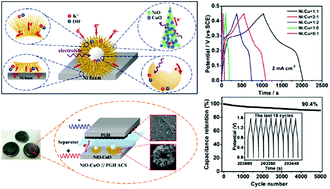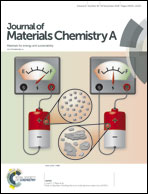Hybrid NiO–CuO mesoporous nanowire array with abundant oxygen vacancies and a hollow structure as a high-performance asymmetric supercapacitor†
Abstract
High specific capacity as well as good cycling stability are crucial for practical applications of supercapacitors, but actually the specific capacitances of transition metal oxide-based electrodes are still far below their theoretical predictions, and their cycling stabilities cannot satisfy the commercial standard due to intrinsically poor electronic conductivity and volume structural changes during charging/discharging processes. Here, we report the synthesis of a hybrid NiO–CuO mesoporous nanowire array with abundant oxygen vacancies which constructs a three-dimensional (3D) hollow architecture via a facile hydrothermal method and subsequent annealing. Compared to single-phase NiO or CuO, the increased O-vacancies on the NiO–CuO hybrid nanowires probably arising from a high number of lattice defects can promote their electronic conductivity, as revealed by XPS O 1s spectra, EPR characterization and HRTEM images. In addition, the 3D hollow structure together with mesoporous nanowires composed of alternately linked NiO and CuO nanocrystals can relax strain stress either in a hollow 3D structure or along a one-dimensional (1D)-direction nanowire, which not only provides a fast diffusion pathway for electrolyte ions and a high surface area with more active sites, but also helps to maintain the structural integrity during charge/discharge cycles. Therefore, the as-prepared NiO–CuO@Ni foam has a high areal capacitance of 4.35 F cm−2 and also a very high specific capacitance of 1450.8 F g−1 at a current density of 2 mA cm−2. Further, it can be utilized directly as a binder-free positive electrode, and assembled with a negative electrode based on a 3D porous graphene hydrogel (PGH) to construct an asymmetric supercapacitor, which shows a wide potential window of 1.6 V and an outstanding cycling stability of 90.4% capacitance retention after 5000 charge/discharge cycles.



 Please wait while we load your content...
Please wait while we load your content...